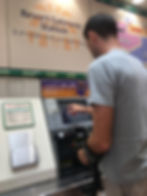Japan: 14 Cultural Differences to Know Before Traveling
- Ashley Sundquist
- Sep 25, 2017
- 6 min read
One of the reasons I love traveling is that it challenges us to consider the notion of what is "normal" in our lives. For example, what is perfectly acceptable in my neighborhood of Santa Monica might be scandalous in Tokyo and vice versa.
I learned about cultural differences in Japan firsthand on a recent trip with my husband, Josh. We decided to explore Japan for our second wedding anniversary and walked about 10 miles every day, taking in the urban landscape of two fascinating cities: Tokyo and Kyoto.
Here are 14 cultural differences to know before traveling to Japan.
1. Dress conservatively
In Southern California where I live, it's not unusual to see someone walking around the neighborhood in a v neck t-shirt or even an athletic top. In Japan? This would be downright outrageous to see in public.
Even though it was 80+ degrees, men and women's fashions are designed with relatively high-cut necklines. I found this fascinating because Tokyo is known the world over for their envelope-pushing street fashion. No matter how flamboyant the outfits, however, it's just not a place for low necklines, particularly for women.
Make sure to pack accordingly.

Here I am in the Gion District of Kyoto. The clothing that I packed for Japan leaned toward the conservative side.
2. Don't point
It's considered overly aggressive to use your fingers to point at people and at things.
If you need to point to something, simply gesture by aiming at your intended target with your connected fingers and your palm outstretched. It feels more like you're recommending something to look at rather than demanding it. It's quite nice once you get used to it! I've been gesturing with my whole hand ever since we got home.
3. Multi-level retail
Intelligent use of retail space is so precious in a massive city like Tokyo, however, I had never seen multi-level retail to this extent. It wasn't uncommon to visit a restaurant on the 5th floor and an owl cafe on the 3rd. It also didn't seem to be a factor that limited consumer exposure or foot traffic. It's simply a different way to layout a huge volume of retailers.
If you don't see your destination right away, check the directory on the ground floor or look for the elevator.

Here's Josh in the Shinjuku neighborhood of Tokyo on our way to the Robot Restaurant.
Each sign on the buildings represents a different retailer within the building.
4. Maid cafes
If you've ever wanted to have a tea with a cute girl in a French maid uniform...it's possible in Tokyo. There are maid cafes everywhere in Akihabara where guests can be waited on hand and foot by youthful entertainers in uniforms. We strolled through Electric Town at night and were invited in by many of these costumed entertainers who retain a doll-like demeanor whenever conversing with a client. We skipped out on this one, but I've heard from friends that it's an intriguing experience.
5. Cash money
I thought robots were going to be processing my transactions to be perfectly honest. It was a huge surprise to learn that almost every transaction is still accomplished with cash. We picked up Japanese Yen at our local bank before the trip and I'm so glad we did. Credit cards are used for larger purchases like hotels and entertainment, but meals, sundries and public transportation are all done in cash. And coins. Lots of coins.
Visit your local bank before the trip to get cash, because you'll get a more competitive rate and won't have to find a money changer once you land in Japan.

We would empty our pockets of all coins and drop whatever we could find into the ticket machine. Usually worked!
6. Silence of the Trains
I've never been among so many perfectly quiet commuters. The trains would be packed to the gills with people, but the only audio sound was the train conductor's stop announcements. There is an unspoken (literally) cultural rule that you are meant to remain quiet in these types of public situations as to not disturb the group harmony. I even saw a PSA sign encouraging commuters to stay sweat-free so they don't bother others. I have to admit, commuting was much more pleasant in a quiet, sweat-free car.
Be respectful of the train culture by not talking on your cell phone, keeping conversations to a slow murmur and never eating or drinking.

7. No trash cans
You won't find Oscar the Grouch here because there aren't any trash cans!! Tokyo is an exceptionally clean city, but you still won't find trash cans at every street corner like in the U.S. Even if you purchase an item at a convenience store, it's unlikely they have trash cans. The day I took my coffee "take-away"style from our hotel, I carried an empty coffee cup with me for hours before finding a trash can!
Littering is a crime, so bring your trash back to the hotel with you if you cannot find a public trash can.
8. Casual smiling is not a thing
One of the first things I noticed in Japan was an absence of casual smiles between strangers. It was rare for a stranger to even make eye contact with me or Josh. There were no casual smiles, no head nods, no eye contact and no physical cues that would suggest we were visible.
You won't see casual smiling in Japan, but that's okay!And it's not because they're unfriendly. Not at all! It's actually a sign of politeness because keeping to yourself and not intruding on another is valued here.
Be yourself, smile at strangers if you'd like to, but just know that it's okay if a smile isn't returned. It's simply a cultural difference!
9. Smoking inside is A-OKAY!
A lot of people still smoke cigarettes in Japan, so it is acceptable to smoke inside. We saw this high-tech smoking chamber that sucked up cigarette smoke with an exhaust vent.
If you're sensitive to cigarette smoke, simply search for a table in an area without smoking. Again, it's a very respectful and polite culture, so smokers tend to congregate in these smoking chambers.

Here's the downstairs smoking room at Kyoto Morris Hostel in Kyoto, Japan. It was super weird to see people smoking inside!
10. Paper Fans and Wash Cloths
It's hot in Japan in the summer and to stay cool, people still use handheld fans. It was crazy to me that one of the most tech-centric nations in the world still uses paper and plastic fans you can buy at 7-11. There are also wash clothes for sale in just about every store from Tokyo Disneyland to the corner convenience store. I learned later that these wash clothes are used by commuters to prevent sweatiness in public.
Buy a fan! Worth the ¥500!

Here's a fan I purchased from 7-11 with characters from a popular Japanese children's book, Anpanman.
The fan was extremely helpful on hot afternoons in Kyoto and when I put it in my beach bag at home, I learned that it was also glow-in-the-dark!
11. Stores open at 11:00am
One of the most surprising things I encountered in Tokyo was how late in the morning stores open. We had a lot of rainy mornings throughout the trip, so it was difficult to find activities until after retailers and department stores opened promptly at 11:00am. From what I experienced, it seems that nighttime outings are much more popular and so retailers open late but stay open until later at night.
12. Some bars are for Japanese speakers only
Golden Gai (Golden Street) is a unique bar district in Shunjuku with dozens of bars within a few hundred yards. It's relatively untouched by all of the commercial development around it and you'd mistake it for a shantytown, if you didn't know what was here. In order to preserve the experience for Japanese locals, some bars prohibited non-Japanese speakers from entering. At first glance, it's surprising, but it makes more sense after you pass a bar of tourists screaming a Jon Bon Jovi song at the top of their lungs.

Here's a tiny Golden Gai establishment that prohibits patrons who cannot speak Japanese.
13. No eating on the go
Japanese people don't eat or drink while they're walking. It's not uncommon in our neighborhood to see someone eating an apple or sipping a coffee while they're out doing errands. There were a few occasions where I wanted a snack, but would refrain because I knew that it was inappropriate to walk around with food.
If you need to grab a snack, there are many parks where you can sit down and enjoy your food. And don't forget, don't eat or drink on the train.

Unfortunately, patrons are not encouraged to take this little marshmallow critter latte to go.
Or maybe, fortunately, because I got to sit down in a cool environment and enjoy it :)
14. Bowing
Bowing is considered a sign of respect in Japanese culture. I really enjoyed this physical way of greeting and thanking one another, because it was a full-body way to show gratitude. One of my favorite memories is bowing and giving my seat to elderly Japanese commuters on the train. In a way, I wanted the bow and its accompanying gesture to express gratitude to this generation for welcoming us into their country despite past animosity and pain between our nations. It truly felt like a privilege to experience the unique culture of Japan and I didn't want
to take that ability for granted.

I received a rare smile from this elderly woman on the train in Kyoto.
What an incredible adventure. While I didn't cover absolutely every cultural difference between Japan and America, I hope you enjoyed reading through some of the most noteworthy. I hope to revisit Japan with Josh someday to learn more!
To all those who adventure unabashedly,
Ashley
























